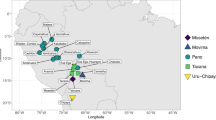Abstract
The Linguistic Atlas of the Middle and South Atlantic States(LAMSAS) is admirably accessible for reanalysis (seehttp://hyde.park.uga.edu/lamsas/,Kretzschmar, 1994). The present paper applies alexical distance measure to assess the lexical relatedness of LAMSAS'ssites, a popular focus of investigation in the past(Kurath, 1949; Carver, 1989; McDavid, 1994). Several conclusions arenoteworthy: First, and least controversially, we note that LAMSAS isdialectometrically challenging at least due to the range of fieldworkers and questionnaires employed. Second, on the issue of whichareas ought to be recognized, we note that our investigations tend tosupport a three-wayNorth/South/Midlands division rather than a two-wayNorth/South division, i.e. they tend to support Kurath and McDavidrather than Carver, but this tendency is not conclusive. Third, weextend dialectometric technique in suggesting means of dealing withalternate forms and multiple responses.
Similar content being viewed by others
References
Bloomfield L. (1933) Language. Holt, Rhinehart and Winston, New York.
Bolognesi R., Heeringa W. (2001) De invloed van dominante talen op het lexicon en de fonologie van Sardische dialecten. Gramma/TTT: Tijdschrift voor Taalwetenschap, 9(1), pp. 45–86.
Carver C. M. (1987, 1989) American Regional Dialects: A Word Geography. The University of Michigan Press, Ann Arbor.
Goebl H. (1984) Dialektometrische Studien: Anhand italoromanischer, rätoromanischer und galloromanischer Sprachmaterialien aus AIS und ALF. 3 Vol. Max Niemeyer, Tübingen.
Gooskens C., Heeringa W. (2003) Perceptual Evaluation of Levenshtein Dialect Distance Measurements using Norwegian Dialect Data. Language Variation and Change, submitted, 8/2002.
Heeringa W. (in prep.) Computational Comparison and Classification of Dialects. Ph.D. Thesis, University of Groningen.
Heeringa W., Nerbonne J., Kleiweg P. (2002) Validating Dialect Comparison Methods. In Gaul, W. and Ritter G. (eds.), Proceedings of the 24th Annual Meeting of the Gesellschaft für Klassifikation. Springer, Heidelberg, pp. 445–452.
Jain K., Dubes R. C. (1988) Algorithms for Clustering Data. Prentice Hall, Englewood Cliffs, New Jersey.
Kretzschmar W. A. (ed.) (1994) Handbook of the Linguistic Atlas of the Middle and South Atlantic States. The University of Chicago Press, Chicago.
Kruskal J. (1983, 1999) An Overview of Sequence Comparison. In Sankoff, D. and Kruskal, J. (eds.), Time Warps, String Edits and Macromolecules: The Theory and Practice of Sequence Comparison. CSLI, Stanford, pp. 1–44.
Kurath H. (1949) A Word Geography of the Eastern United States. University of Michigan Press, Ann Arbor.
Kurath H., McDavid R. (1961) The Pronunciation of English in the Atlantic States: Based upon the Collections of the Linguistic Atlas of the Eastern United States. University of Michigan Press, Ann Arbor.
Labov W. (1991) The Three Dialects of English. In Eckert, P. (ed.), New Ways of Analyzing Sound Change. Academic Press, New York, pp. 1–44.
Manning C., Schütze H. (1999) Foundations of Statistical Natural Language Processing. MIT Press, Cambridge.
McDavid R. (1994) Dialects of the LAMSAS Region. In Kretzschmar, W. A. (ed.), Handbook of the Linguistic Atlas of the Middle and South Atlantic States. The University of Chicago Press, Chicago, pp. 147–153 (written in 1984, shortly before McDavid's death).
Nerbonne J., Heeringa W. (1998) Computationele Vergelijking en Classificatie van Dialecten. Taal en Tongval, 50/2, pp. 164–193.
Nerbonne J., Heeringa W., Kleiweg P. (1999) Edit Distance and Dialect Proximity. In Sankoff, D. and Kruskal, J. (eds.), Time Warps, String Edits and Macromolecules: The Theory and Practice of Sequence Comparison, 2nd ed. CSLI, Stanford, CA, pp. v–xv.
Nerbonne J., Heeringa W., van den Hout E., van der Kooi P., Otten S., van de Vis W. (1996) Phonetic Distance between Dutch Dialects. In Durieux, G., Daelemans, W. and Gillis, S. (eds.), CLIN VI: Proc. from the Sixth CLIN Meeting. Center for Dutch Language and Speech, University of Antwerpen (UIA), Antwerpen, pp. 185–202. Also available as http://www.let.rug.nl/~nerbonne/ papers/dialects.ps.
Schneider E. (1988) Qualitative vs. Quantitiative Methods of Area Delimitation in Dialectology: A Comparison Based on Lexical Data from Georgia and Alabama. Journal of English Linguistics, 21, pp. 175–212.
Séguy J. (1971) La relation entre la distance spatiale et la distance lexicale. Revue de Linguistique Romane, 35, pp. 335–357.
Speelman D., Grondelaers S., Geeraerts D. (2003) Profile-Based Linguistic Uniformity as a Generic Method for Comparing Language Varieties. Computers and the Humanities, 37(3), pp. 317–337.
Wolfram W., Schilling-Estes N. (1998) American English. Blackwell, Malden, Massachusetts.
Author information
Authors and Affiliations
Rights and permissions
About this article
Cite this article
Nerbonne, J., Kleiweg, P. Lexical Distance in LAMSAS. Computers and the Humanities 37, 339–357 (2003). https://doi.org/10.1023/A:1025042402655
Issue Date:
DOI: https://doi.org/10.1023/A:1025042402655




